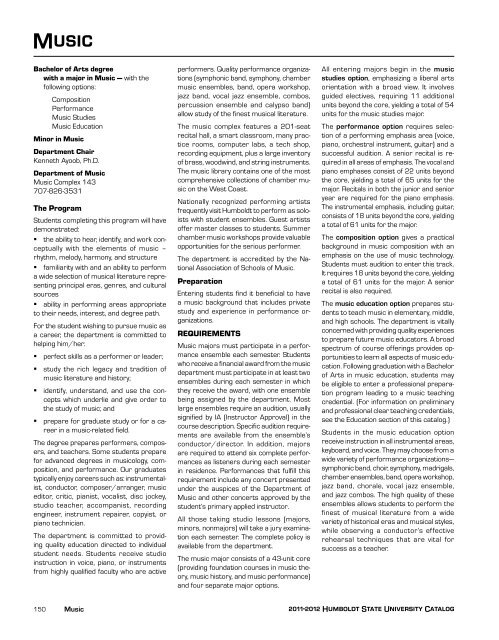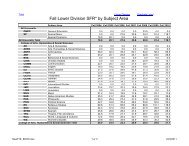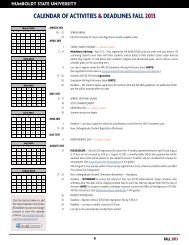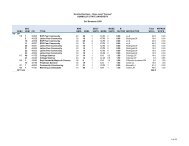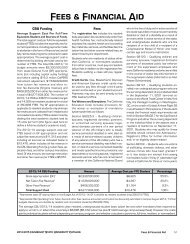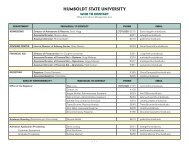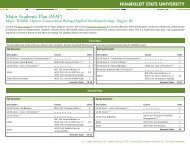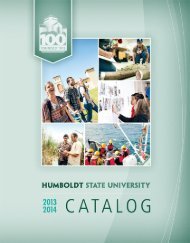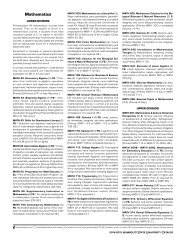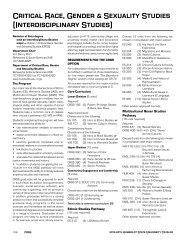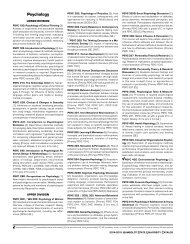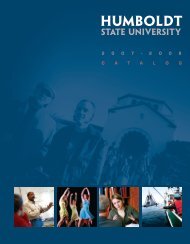2011-12 Academic Year - Bad Request - Humboldt State University
2011-12 Academic Year - Bad Request - Humboldt State University
2011-12 Academic Year - Bad Request - Humboldt State University
You also want an ePaper? Increase the reach of your titles
YUMPU automatically turns print PDFs into web optimized ePapers that Google loves.
Music<br />
Bachelor of Arts degree<br />
with a major in Music — with the<br />
following options:<br />
Composition<br />
Performance<br />
Music Studies<br />
Music Education<br />
Minor in Music<br />
Department Chair<br />
Kenneth Ayoob, Ph.D.<br />
Department of Music<br />
Music Complex 143<br />
707-826-3531<br />
The Program<br />
Students completing this program will have<br />
demonstrated:<br />
the ability to hear, identify, and work conceptually<br />
with the elements of music –<br />
rhythm, melody, harmony, and structure<br />
familiarity with and an ability to perform<br />
a wide selection of musical literature representing<br />
principal eras, genres, and cultural<br />
sources<br />
ability in performing areas appropriate<br />
to their needs, interest, and degree path.<br />
For the stu dent wishing to pursue music as<br />
a career, the department is committed to<br />
helping him/her:<br />
perfect skills as a performer or leader;<br />
study the rich legacy and tradition of<br />
music lit er a ture and history;<br />
identify, understand, and use the concepts<br />
which un de r lie and give order to<br />
the study of music; and<br />
prepare for graduate study or for a career<br />
in a music-related field.<br />
The degree prepar es per form ers, composers,<br />
and teachers. Some students prepare<br />
for ad vanced de grees in musicology, compo<br />
si tion, and per form ance. Our grad uates<br />
typically en joy careers such as: instrumentalist,<br />
con duc tor, composer/arranger, music<br />
editor, cri tic, pianist, vocalist, disc jockey,<br />
studio teach er, accompanist, recording<br />
engineer, instrument re pairer, copyist, or<br />
piano technician.<br />
The department is committed to providing<br />
quality education directed to individual<br />
student needs. Students receive studio<br />
instruction in voice, piano, or instruments<br />
from highly qualified faculty who are active<br />
performers. Quality performance organizations<br />
(symphonic band, symphony, chamber<br />
music ensembles, band, opera workshop,<br />
jazz band, vocal jazz ensemble, combos,<br />
percussion ensemble and calypso band)<br />
allow study of the finest musical literature.<br />
The music complex features a 201-seat<br />
recital hall, a smart classroom, many practice<br />
rooms, computer labs, a tech shop,<br />
recording equipment, plus a large inven tory<br />
of brass, woodwind, and string instruments.<br />
The music library contains one of the most<br />
comprehensive collections of chamber music<br />
on the West Coast.<br />
Nationally recognized performing artists<br />
fre quently visit <strong>Humboldt</strong> to perform as soloists<br />
with student ensembles. Guest artists<br />
offer master classes to students. Summer<br />
chamber music workshops provide valuable<br />
opportunities for the serious performer.<br />
The department is accredited by the National<br />
Association of Schools of Music.<br />
Preparation<br />
Entering students find it beneficial to have<br />
a music background that includes private<br />
study and experience in performance organizations.<br />
REQUIREMENTS<br />
Music majors must participate in a performance<br />
ensemble each semester. Students<br />
who receive a financial award from the music<br />
department must participate in at least two<br />
ensembles during each semester in which<br />
they receive the award, with one ensemble<br />
being assigned by the department. Most<br />
large ensembles require an audition, usually<br />
signified by IA (Instructor Approval) in the<br />
course description. Specific audition requirements<br />
are available from the ensemble’s<br />
conductor/director. In addition, majors<br />
are required to attend six complete performances<br />
as listeners during each semester<br />
in residence. Performances that fulfill this<br />
requirement include any concert presented<br />
under the auspices of the Department of<br />
Music and other concerts approved by the<br />
student’s primary applied instructor.<br />
All those taking studio lessons (majors,<br />
minors, nonmajors) will take a jury examination<br />
each semester. The complete policy is<br />
avail able from the department.<br />
The music major consists of a 43-unit core<br />
(providing foundation courses in music theory,<br />
music history, and music performance)<br />
and four separate major options.<br />
All entering majors begin in the music<br />
studies option, emphasizing a liberal arts<br />
orien ta tion with a broad view. It involves<br />
guid ed electives, requiring 11 additional<br />
units beyond the core, yielding a total of 54<br />
units for the music studies major.<br />
The performance option requires se lection<br />
of a performing emphasis area (voice,<br />
piano, orchestral instrument, guitar) and a<br />
successful audition. A senior recital is required<br />
in all areas of emphasis. The vocal and<br />
piano emphases consist of 22 units beyond<br />
the core, yielding a total of 65 units for the<br />
major. Recitals in both the junior and senior<br />
year are required for the piano emphasis.<br />
The instrumental emphasis, including guitar,<br />
consists of 18 units beyond the core, yielding<br />
a total of 61 units for the major.<br />
The composition option gives a practical<br />
background in music composition with an<br />
emphasis on the use of music technol ogy.<br />
Students must audition to enter this track.<br />
It requires 18 units beyond the core, yielding<br />
a total of 61 units for the major. A sen ior<br />
recital is also required.<br />
The music education option prepares students<br />
to teach music in elementary, middle,<br />
and high schools. The department is vitally<br />
concerned with providing quality experiences<br />
to prepare future music educators. A broad<br />
spectrum of course offerings provides opportunities<br />
to learn all aspects of music education.<br />
Following graduation with a Bachelor<br />
of Arts in music education, students may<br />
be eligible to enter a professional preparation<br />
program leading to a music teaching<br />
credential. (For information on preliminary<br />
and professional clear teaching credentials,<br />
see the Education section of this catalog.)<br />
Students in the music education option<br />
receive instruction in all instrumental areas,<br />
keyboard, and voice. They may choose from a<br />
wide variety of performance organizations—<br />
symphonic band, choir, symphony, madrigals,<br />
chamber ensembles, band, opera workshop,<br />
jazz band, chorale, vocal jazz ensemble,<br />
and jazz combos. The high quality of these<br />
ensembles allows students to perform the<br />
finest of musical literature from a wide<br />
variety of historical eras and musical styles,<br />
while observing a conductor’s effective<br />
rehearsal techniques that are vital for<br />
success as a teacher.<br />
150 Music<br />
<strong>2011</strong>-20<strong>12</strong> <strong>Humboldt</strong> <strong>State</strong> <strong>University</strong> Catalog


